Media | Articles
We watched Acura build the final NSX supercar
Del Close, the famous improv coach who taught John Belushi, Dan Aykroyd, Bob Odenkirk, and countless others the ins and outs of comedic timing, died in 1999, just five days before his 65th birthday. While he slowly succumbing to emphysema in the hospital, his acolyte, Bill Murray, organized an unusual birthday party—a living wake, at which all of Close’s friends and former students gathered to pay tribute to the man who taught them how to be funny. From his deathbed, Close had the rare opportunity to truly take stock. The partygoers, in turn, were able to say their goodbyes in person with no regrets. The party is memorialized in a home video that now resides on YouTube. At the very beginning, Close, on the phone with members of the Upright Citizens Brigade comedy troupe, states: “You know, as I leave it, I begin to realize that we really haven’t done such a bad job.”

By the time that you read this, the second-generation Acura NSX will already be dead. We were lucky enough, late last year, to attend Acura’s living wake of the final NSX, a metallic gray Type S with serial number 350/350. We had the opportunity to witness that final car begin its life as a welded aluminum subframe before its slow, methodical journey through each assembly station at Honda’s Performance Manufacturing Center in Marysville, Ohio.
The death of a supercar is always a sad day. We do not begin to truly appreciate what we treasure most in this world until it is gone. When a beloved celebrity dies, fans, family, and colleagues are ready to offer heartfelt condolences. There’s generally a sense of regret that we never told those we’ve lost just how much they mattered while they were still with us.

Honda’s Performance Manufacturing Center (PMC) is deeply tied with into the history of the second-generation NSX. The factory was designed in concert with the car itself, optimized for the express purpose of building a modern Japanese supercar in the rolling farmland of central Ohio. All things come to an end however, and it was noted during our tour that the PMC is not “the NSX factory.” PMC, Acura maintains, has a long and exciting road ahead of it (more on that later).
Marketplace
Buy and sell classics with confidence
PMC is nestled in the shadow of the big Marysville Honda plant, sprawling over four million square feet. PMC itself is just 180,000 square feet, and it serves as a clinically-clean showpiece of Honda’s manufacturing capabilities. By comparison, the big NASCAR Cup Series teams—Hendrick Motorsports, Joe Gibbs Racing, and others—occupy shops over twice as large. PMC was built to show off Honda’s manufacturing muscle, and similar Chevrolet’s Performance Build Center inside the Bowling Green, Kentucky factory, much of the work here is done by hand. Robots number in the single digits, most of them being tasked with welding the NSX’s space frame. Each NSX features 860 MIG welds, with many more rivets and screws—all set and tightened by human hands—holding the car together.
When we pulled up to PMC on a Wednesday morning, I expected to encounter a sense of melancholy looming over the operation as I toured the facility. Instead, I walked into a celebration. The PMC employees, hand-picked from the big Honda factory looming behind them, walked around in spotless white coveralls with a palpable sense of pride and purpose. The NSX has been a staple of their working lives for the past five years, but they’re eager to see what comes next.

Incidentally, the only employees of PMC without promising job security are the welding robots. Future PMC Edition cars—limited-run, hand-built versions of existing Acura models like the TLX and MDX—will have their unibody structures pre-finished at the big Honda plant next door and delivered as bodies-in-white, with about two hours of hand-fitting to adjust the already-industry-standard panel gaps to perfection. (Similarly, Honda Civic race car shells will have roll cages welded in by professionals at this facility.) For the time being, the welding robots, tucked into stations behind metal cages framing darkened inspection glass, will lay dormant.

Beyond the welding stations, you’ll find “closures,” or areas where the doors, hood, and trunk lid for each NSX are completed and prepared for paint. This zone, along with many others in the plant, blend old-world craftsmanship with modern technology. If you’ve viewed any YouTube footage of small-scale sports car factories like Morgan’s Malvern facility, you’ll know precisely what I mean. The surgically-clean factory is well-stocked with all manner of high-tech equipment, but the final touches are handled by human hands and inspected with human eyes. Each car spends roughly four hours in each assembly process, from welding all the way through to final assembly.

Beyond the closures station, a row of nine tanks is lined up to clean the bare metal and apply an even layer of e-coat primer to the unibody and the closures. The car is dipped in each tank and allowed to drain before moving on to the next one. The water tanks get progressively cleaner, removing impurities from the shell and allowing the e-coat to adhere properly. The process is very thorough, and I was surprised to learn later that this is one of the major bottlenecks at PMC. Just a handful of cars can make it through the e-coat process in a single shift, and only two or three completed cars make it out of the facility each day. Despite the comparatively small size of the facility, each NSX is fully assembled indoors from start to finish, not seeing the light of day until it leaves the adjacent storage facility.

Next, the completed unibodies are attached to a dolly and seam sealer is applied. Each NSX will remain married to this dolly for the duration of its assembly process, until wheels and tires are added towards the very end. Incidentally, one of the final touches for each NSX is the rear Acura badge. NSX buyers who opted to participate in the Acura Insider Experience had the opportunity to tour PMC as I did, culminating in the completion of their own custom-ordered NSX. Then, these Insiders get the privilege of applying the Acura badge and the individually numbered engine plate themselves. Owners who opted to stay home were treated to detailed photos of their NSX as it moved through each assembly process, with a final photo of the completed car in front of a giant American flag, accompanied by a large poster featuring the sequential build number of each NSX Type S … That same procedure was followed for the Acura-supplied photos seen here, albeit with a bit more gravity and fanfare.
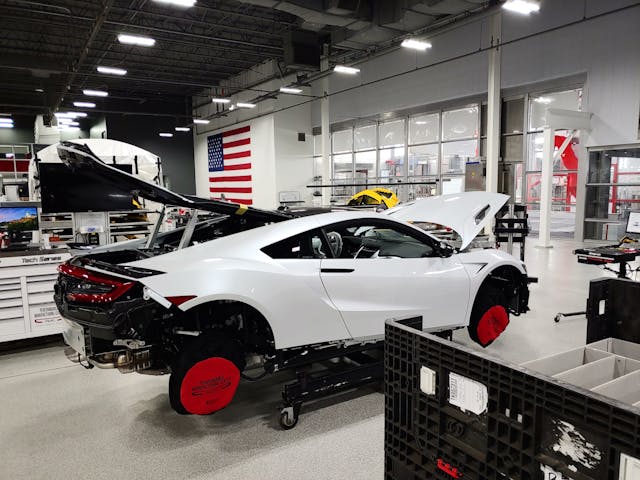
Following seam sealer, the assembly process begins, with the paint and body shop running concurrently. The body shop, which sits roughly in the center of PMC, uses robots to apply paint, with a final coat and any required touch-up applied by an expert painter. Once the paint has dried and cured, numerous inspection stations, lit by bright fluorescent lights, expose minor imperfections to be noted for repair. A separate room filled with more fluorescent lights and high-speed buffers is hard at work polishing the paint to a level of perfection rarely seen outside the show-car circuit. The painted panels for each car are kept together on a covered cart, and are some of the last components applied to each NSX to prevent damage during assembly.
A subtle PMC trademark is their ability to mask incredibly sharp, fine lines on body panels. When you notice the two-tone black detailing on the NSX Type S, such as on the rocker panels and beneath the headlights, it’s worth noting that those aren’t separate components, but instead carefully masked and painted details.

Assembly of each NSX begins from the inside out, with interior and electrical components being among the first items fitted to the bare shell. Shortly thereafter, the roof and engine cover are fitted. The panel surrounding the door—comprising the pillars and rocker panel—is the only exterior body panel that isn’t bolted into place. Instead, a robot applies sealer, and two factory employees carefully lift the panel, align it with a jig, and place it on its respective side of the car. The jig will remain in place as the bonded panel’s adhesive cures.
Once the panel is suitably bonded, each NSX moves to a station with a lift, where the engine—and its attendant subframe—is bolted into place. The engines are built at a nearby facility, and pre-broken in. Theoretically, a new NSX owner could start their car for the first time, bounce off the rev limiter, and do no damage. Each bolt on the subframe is tightened to spec with a digital torque wrench, which records the torque spec of each bolt for each NSX. This, possibly better than any other operation in the PMC, displays the ideal synergy of cutting-edge tech and old-world craftsmanship.

From there, the NSX begins to take on a recognizable shape as final assembly steps bolt the front subframe, remaining body panels, and trim in place. Shortly after the wheels and tires are bolted on, each NSX goes through the wheel alignment process. The technician in charge of this uses a special ergonomic chair that hangs below the alignment rack and was patented specifically for this purpose. Then, the headlights are aligned, and each NSX goes through a rigorous testing regimen that includes an engine dyno, a shock dyno, and a water intrusion test.
At the end of the assembly line, we were greeted by a red and black Acura TLX with bronze wheels – PMC’s next project. Just 350 TLX PMC Edition cars will be built, to the same standards as the NSX. Previously, the PMC had taken short breaks from NSX production for similarly short runs of similarly hand-assembled MDX and RDX models. Acura representatives were eager to show off the black-painted roof panel. Unlike many cars, the roof panel on the TLX isn’t separate; it’s brazed into place, joining the pillars on both sides as one panel. This is extremely difficult to get right, and the black-painted roof has become something of a PMC trademark.
That level of pride in the small details that others may not notice is a hallmark of how PMC operates. Twenty years ago, it would have been unthinkable to imagine a Japanese company building their best products among the endless cornfields of the American Midwest. After visiting PMC, we can’t imagine them doing it any other way. There’s a contagious sense of pride that you feel after seeing the employees of PMC go about their work. As an Ohio native, I’m more than little proud that something like the NSX was built in my backyard.
As I leave PMC and the NSX, I begin to realize—we really haven’t done such a bad job.
Check out the Hagerty Media homepage so you don’t miss a single story, or better yet, bookmark it.
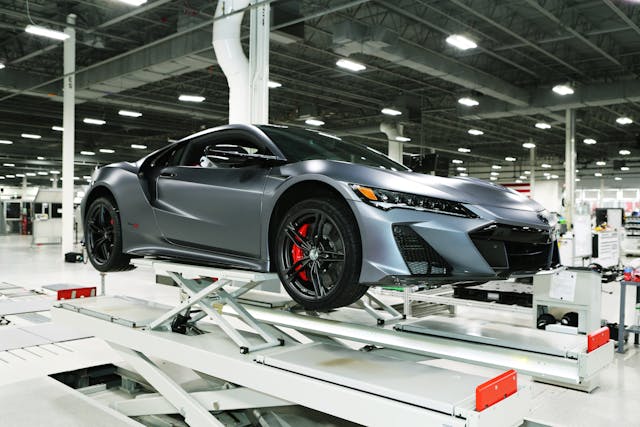












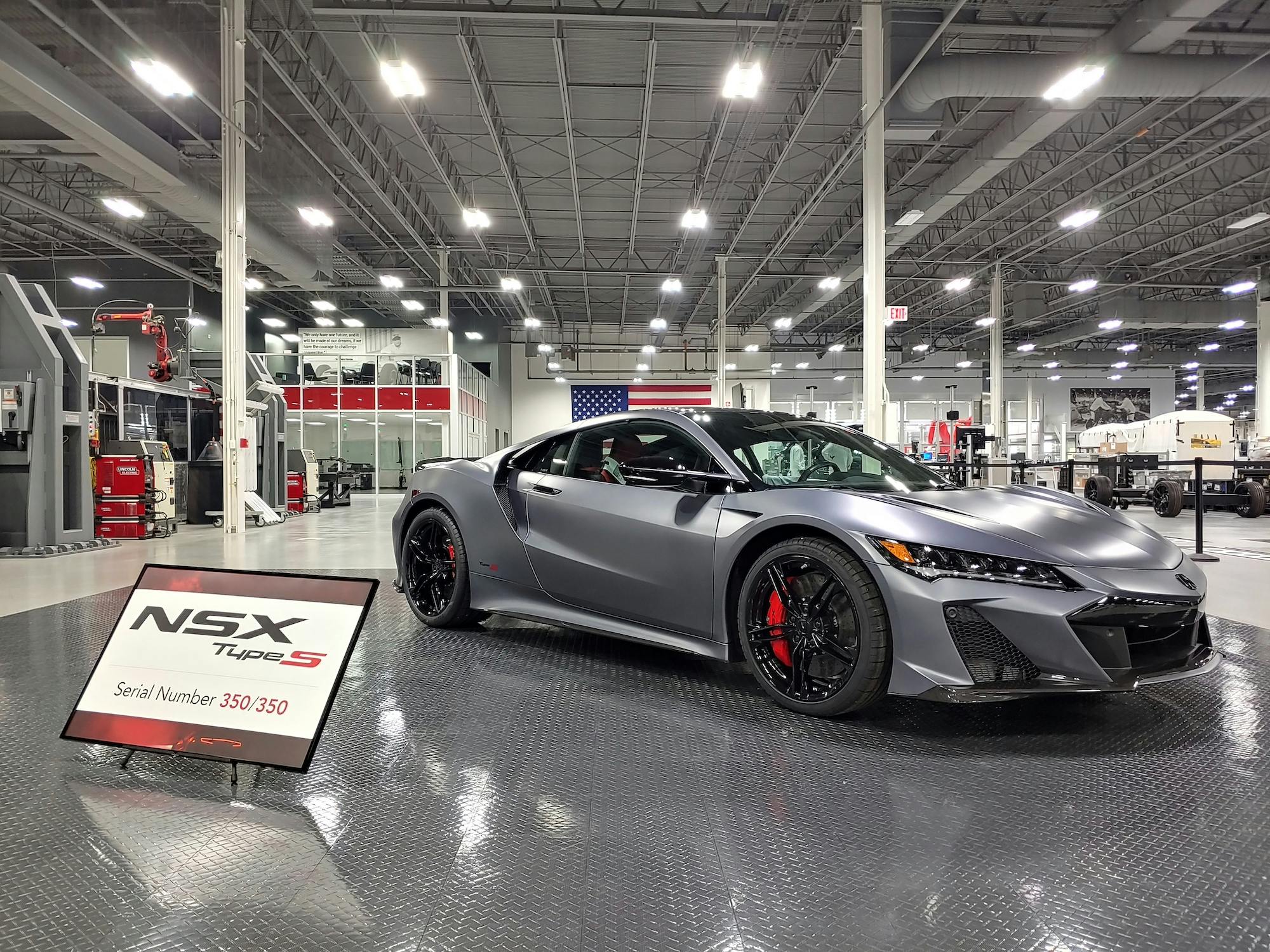


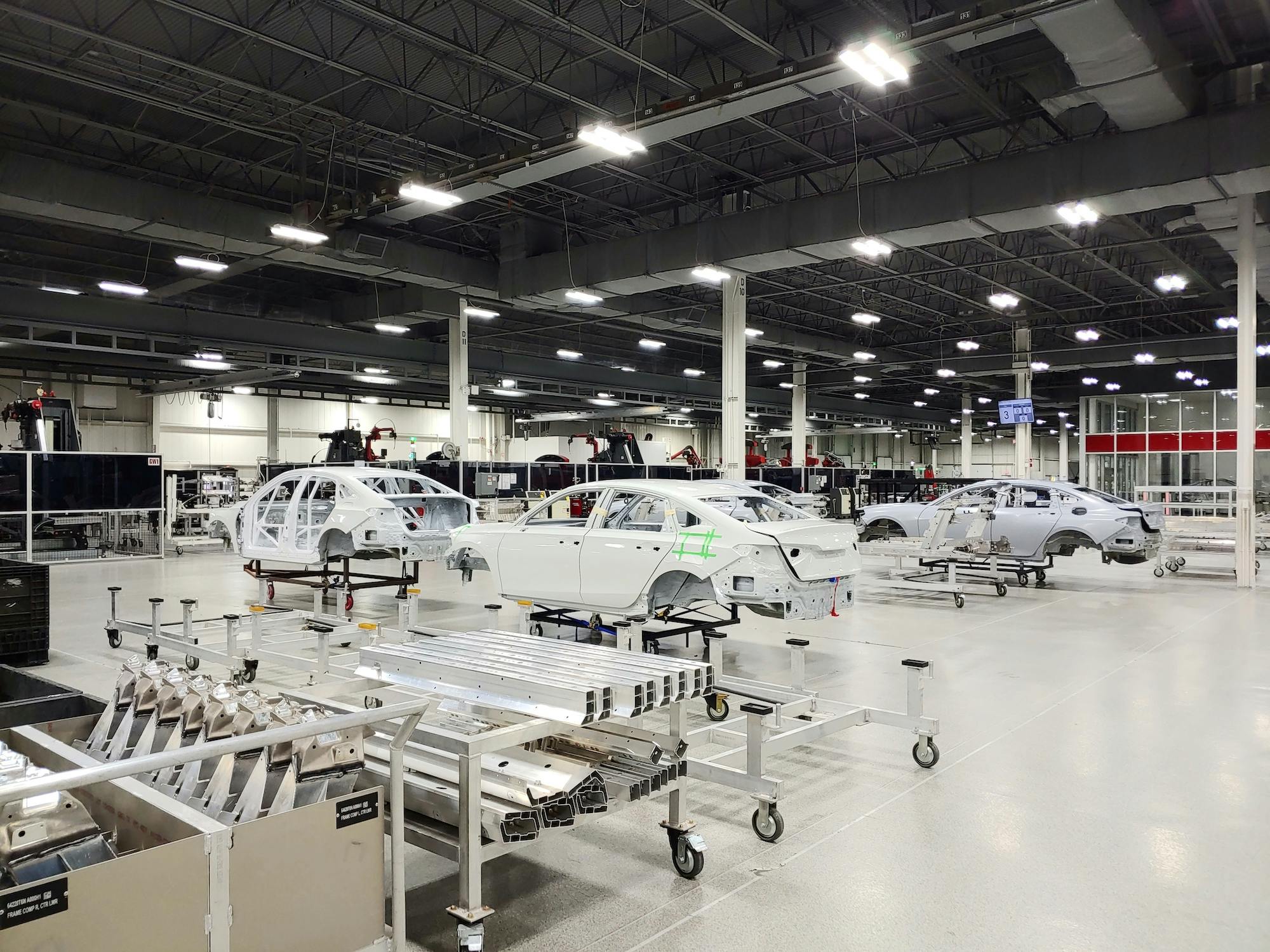
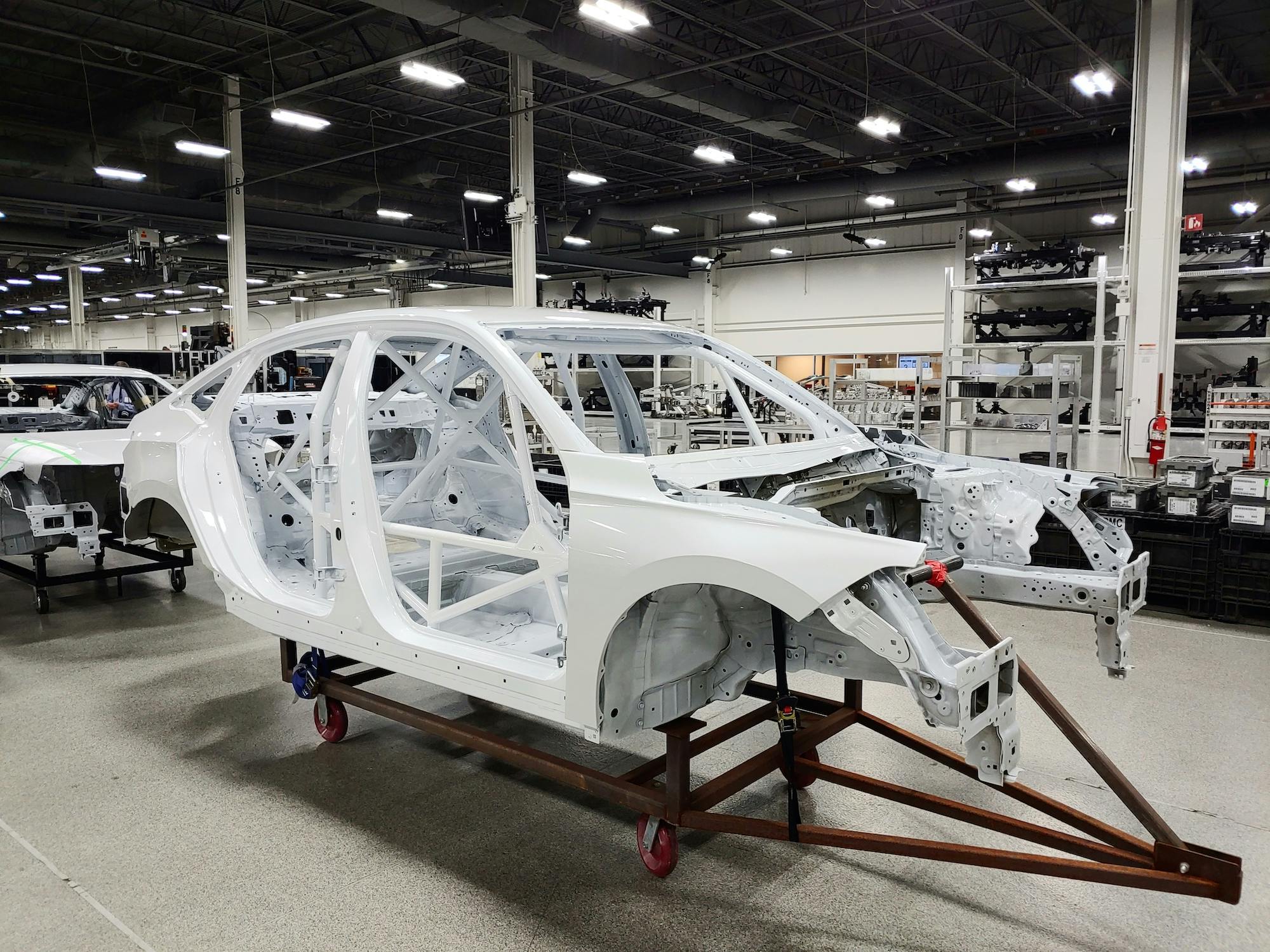















Cam, I’m so sorry, but most of us will not mourn the passing of this car.
WHY? For myriad reasons, such as its ridiculous pricing, given its performance and specs, not to mention the (entirely subjective) matter of styling.
The original NSX was such an enormously revolutionary cloudburst in the automotive sky, in that it trounced the trousers off all of the primo-European motor/supercars, and at a nearly affordable price; much like Lexus’ LS400 so handily accomplished against the luxury European sedan marketplace.
Competition? HA!
My own experience with the first NSX was limited to drooling over a Dr.’s version where I worked, to feeling a bit smug about having almost the same engine in my 1997 Accord V6.
ANY who bought, and miraculously, still own those first generations — you are among the MOST fortunate of car purchasers.
Of course I envy you, but must also admire you.
P.S.- Of course I’d happily accept one of these as some sort of prize, but honestly; I’d prefer either a C8 Corvette, or the current Lexus whatever consumer-supercar.
I do have a 2022 C8. My first impression as I read this article was how similar in appearance the two cars seem. Having sold high performance elastomers to Honda in the early ’80’s, I’ve been in the Marysville plant several times and always marveled at the gleaming floors and spotless spaces. I suspect the NSX is, as discussed, superbly well assembled. For the money, however, the C8 was a better buy for me.
Agreed whole Heartedly. Not aesthetically pleasing car. No Generational Upgrades. Heavy hybrid system. Pulled up to work One day and a coworker had a brand new 2019 model. I was in my lotus Elise SC. Everyone else was admiring my car rather than his 2.5 times more expensive car. Looks can be everything!
This was a car that took too long to come together, was too complex for it’s own good and too pricey for what it delivered. It is a very good car but the fact is it was an American Acura/Honda car not a designed and made in Japan Honda/Acura NSX and I think that corporate didn’t love it as much because of that. I like it but I still think had this been a lighter car without the Hybrid GT-R fighter it could have been a great car.